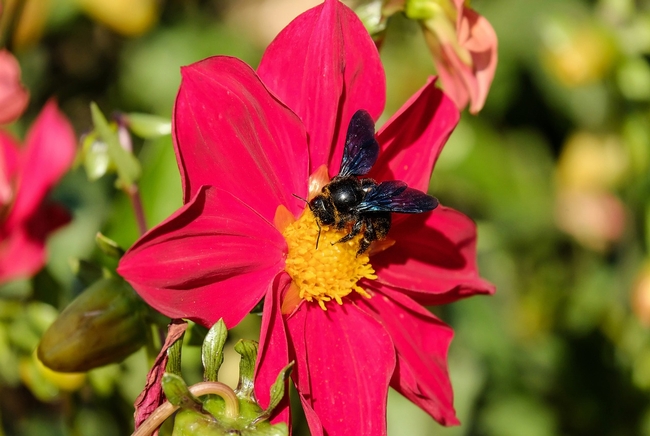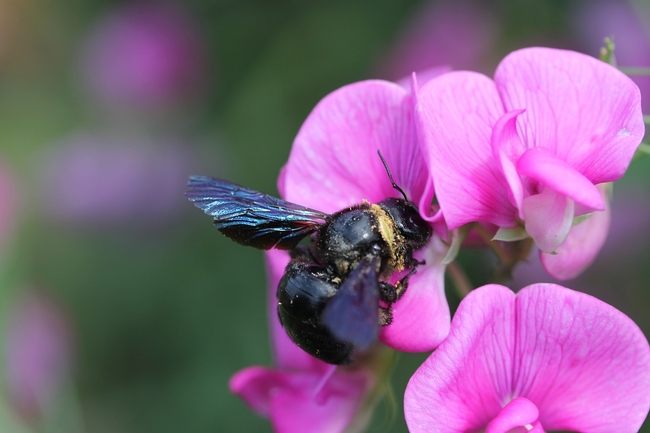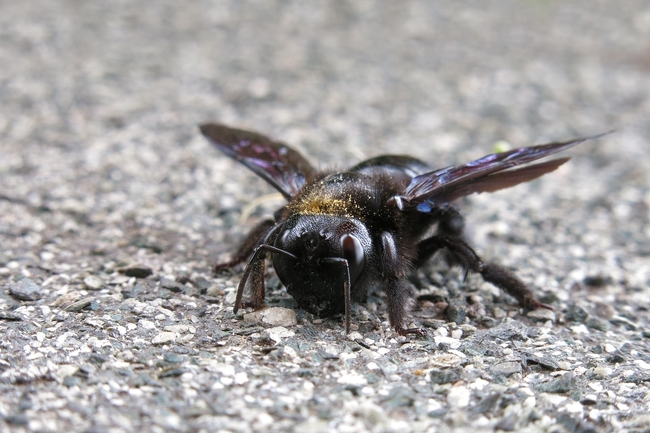For many years I've heard about carpenter bees, but this year my relationship with these amazing bees became close and personal.
On one side of our 100-year-old house is a peach tree that stands about seven feet tall in summer. The trunk curls around in a pleasing shape. But at one time, a substantial branch was cut, leaving a surface about six inches across.
While gardening under the tree one day, I spotted a large, fuzzy golden-orange bee wiggle into a hole in this sawed-off branch. I realized I was looking at a carpenter bee. After that, I stayed clear of the area, not knowing how friendly the bee might be. It might not appreciate me scuffling around under the branch, which was less than three feet from the ground.
Several days later, I saw a large pile of fresh sawdust on the other side of the cut-off branch. Hmm, I thought, there is definitely some serious carpentry happening here. A duplex, perhaps? I decided to find out more about my new neighbors.
The California carpenter bee (Xylocopa californica) is native to western North America. Carpenter bees are classified as long-tongued bees and are the largest native bees in the U.S. They are a hefty one inch long, oval, with six legs and antennae.
The carpenter bee receives its name from its nesting habit. It digs into wood—often a dead tree or fallen log—to make a nest. The bees prefer softer, older wood, but in urban areas, they will also make a home in new construction wood. The bee makes its nest by creating long, double-ended passages in the limbs of trees, just as I saw it doing in my peach tree.
The female carpenter bee is solid black, while the male is commonly known as the “teddy bear bee” because of its fuzzy orange exterior and gold-green eyes. The male does not sting and is rarely seen. The female stings, however, and the result can be painful.
Male and female carpenter bees have different jobs. The sole responsibility of the female is to excavate a series of tunnels using her powerful mandibles to make a home for her offspring. Tunnel entrances are about ½-inch in diameter, just big enough for the bee to enter. The tunnel interior may be an inch in diameter.
After she completes the tunneling, the female will create six to eight individual cells. She provisions each cell with a ball of bee bread, consisting of pollen and nectar. She will lay her eggs in the cells, then seal off the tunnel with sawdust. Eggs hatch and reach adulthood in about seven weeks. The adults remain in the nest for several weeks before digging their way out in the fall.
Females lay eggs only once a year. The new generation emerges in April and May and repeats this cycle. Carpenter bees may return to the same nest for many generations, expanding and renovating the nest year after year.
The objective of the male bee is to attract the female. The male lingers near a non-flowering plant, often near a food source, and releases sweet-smelling pheromones that lure the opposite sex. The male carpenter bee is always on the defense; after mating, its main job is to protect the nest. Although it does not have a stinger, its larger size and aggressive nature help it ward off unwanted visitors.
Carpenter bees may be a nuisance, but they are important pollinators. Approximately 15 percent of our state's crops are pollinated by native bees.
Robbin Thorp, an emeritus professor of entomology at UC Davis before his death in 2019, was a renowned bee expert. He cited carpenter bees as important pollinators of crops such as passion fruit, blueberries, melon, tomatoes, and eggplant. “They may even pollinate flowers while ‘nectar robbing' from them,” he wrote.
The carpenter bee's practice of tunneling into wood is an initial step in the recycling process in natural communities.
We can encourage carpenter bees by creating nesting sites in our yards. All it takes is a few materials, such as wooden logs, boards, or blocks. Planting nectar plants that provide food in each season will help them survive in an urban environment.
The bees' nest doesn't take up much real estate in my yard. I look forward to watching them remodel the home next year.
Workshop: Join UC Master Gardeners of Napa County for “Growing Cool-Season Vegetables” on Saturday, August 10, from 10 am to noon, at University of California Cooperative Extension Office, 1710 Soscol Avenue, Napa. From lettuce and carrots to more exotic greens and vegetables, many delicious choices await the fall and winter gardener. This hands-on workshop provides growing tips from planning and planting to harvest and into the kitchen. Register here.
Workshop: Join UC Master Gardeners of Napa County for “Growing Cool-Season Vegetables” on Sunday, August 18, from 2 pm to 4 pm, at Yountville Community Center, 6516 Washington Street, Yountville. From lettuce and carrots to more exotic greens and vegetables, many delicious choices await the fall and winter gardener. This hands-on workshop provides growing tips from planning and planting to harvest and into the kitchen. Register through Yountville Parks and Recreation.After clicking the link, find the registration page at
Adult Activity > UC Master Gardeners > Fall & Winter Gardening.
Fall Faire: Join the UC Master Gardeners of Napa County for an entertaining and educational event on Saturday, September 28, from 1 pm to 4 pm, outdoors at University of California Cooperative Extension, 1710 Soscol Avenue, Napa. Enjoy exhibits on composting, monarch butterflies, succulents, water conservation, bees and more. The program includes activities for kids, a scarecrow contest, giveaways, and music. Admission is free.
Help Desk: The Master Gardener Help Desk is available to answer your garden questions on Mondays and Fridays from 10 am until 1 pm at the University of California Cooperative Extension Office, 1710 Soscol Avenue, Suite 4, Napa. Or send your questions to mastergardeners@countyofnapa.org. Include your name, address, phone number and a brief description.
Become a Master Gardener Volunteer: UC Master Gardeners of Napa County is now accepting applications for the Class of 2025. Visit napamg.ucanr.edu to read the informational brochure, then register to attend a mandatory information session for applicants. Application deadline is 5 pm on September 25.


